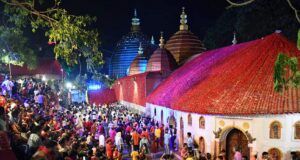Prelims Bits

Context
Thousands of devotees are participating in the Ambubachi Mela at the Kamakhya Temple in Assam, an important annual religious festival.
What is Ambubachi Mela?
- Meaning:
- “Ambubachi” translates to “water flowing”, symbolizing fertility and the Earth’s cycles.
- Occasion:
- Held annually in June at the Kamakhya Temple, Assam
- Marks the menstruation period of Goddess Kamakhya
- Celebrated as part of Tantric fertility worship
- Cultural Significance:
- Symbolises the onset of monsoon
- Reinforces the Earth as a fertile woman, a concept found in many agrarian cultures
- Reflects deep Tantric and Shakta traditions of India
- Ritual Practices:
- Temple is closed for 3 days during the goddess’s menstruation
- Farming activities are avoided during this period
- Thousands of ascetics, sadhus, and devotees gather — making it one of Eastern India’s largest religious congregations
About Kamakhya Temple
- Location:
- Situated on Nilachal Hill, Guwahati, Assam
- Lies on the southern bank of the Brahmaputra River
- Architecture:
- Built in the Nilachala style, which combines Nagara and Mughal architectural elements
- Religious Significance:
- One of the 51 Shakti Peethas — the site where Goddess Sati’s yoni is believed to have fallen
- Instead of an idol, the temple houses a yoni-shaped stone and a natural spring
- Presiding Deity:
- Goddess Kamakhya (Kameswari) — associated with fertility, desire, and power
- Central to Tantric Shaktism, especially the Kulachara tradition
- Historical Background:
- Reconstructed in 1565 by Koch king Naranarayan after being destroyed, possibly during Hussein Shah’s 1498 invasion
- Mentioned in Kalika Purana and Yogini Tantra, signifying ancient textual importance
- Represents a synthesis of Aryan and tribal belief systems




